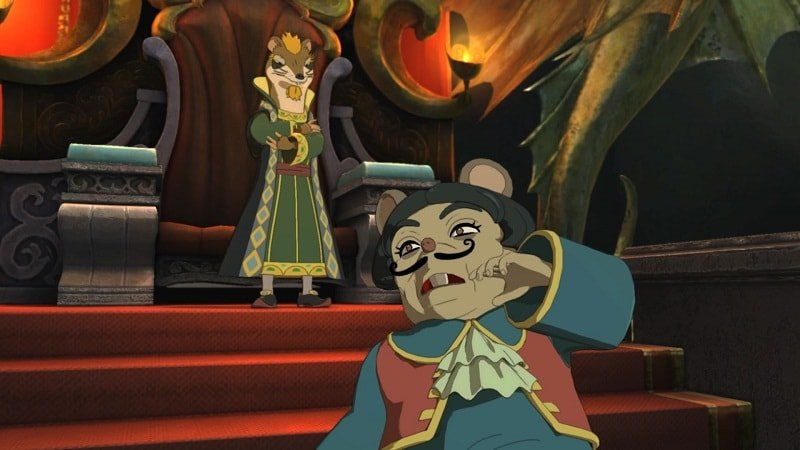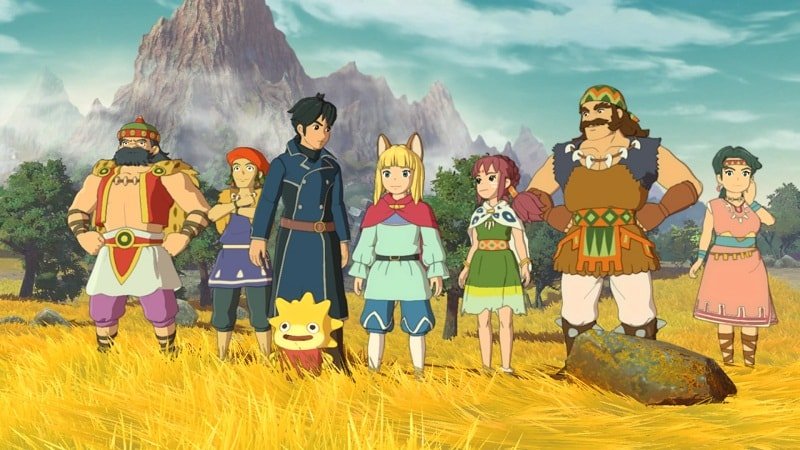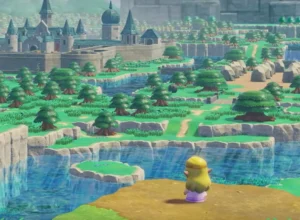As Marvel Studios, Lucasfilm, and 20th Century Fox can all attest, nothing can stop a coup d’état from the house of mouse.
So the boy king, Evan Pettiwhisker Tildrum, discovers one stormy night in his castle. “It’s time for mousekind to assume its rightful place at last,” decrees the usurper, Otto Mausinger, a grinning rodent in robed finery. It’s tough to argue with a line like that. Whatever has gotten his hackles up, he wants the kitten king dead. Fortunately for you, Evan escapes via the sewer – flushed out of one kingdom and forced to whip up another from scratch.
Of course, it isn’t to Disney that Ni No Kuni II: Revenant Kingdom is in thrall; it’s that numinous, dreaming cousin, Studio Ghibli. While no longer partnered with Level-5, as they were for the first game, key members of the Ghibli rabbinate remain: composer Joe Hisaishi (Howl’s Moving Castle, Spirited away), and ex-Ghibli animator Yoshiyuki Momose (Whisper of the Heart, Princess Mononoke).
They both put fresh paint on the usual JRPG clichés – screwy character designs, bad hair, the power of love prevailing. The game’s setting, Ding Dong Dell, is a place of billowy beauty, painted in the pale greens and pinks of salt water taffy. As Evan capers across the land, you’ll see creatures and cities unlike those you’ve seen before.
Take Goldpaw, for example: a nocturnal casino city at the base of a mountain. It’s bedecked like Shanghai in the 1930s, the Paris of the Orient, lit up like Grauman’s Chinese theatre. Its citizens are largely canine, some with splotches like they’ve been given a black eye in a punch-up, others gruff with droopy jaws and barrel chests. The mayor is called master Pugnacious. He is, of course, a pug. It pulls off the kind of cute that Rare used to get away with before everyone grew up or got tired.
There’s a thickly matted scandal in Goldpaw, involving taxes and political chicanery, which you’ll have to comb the knots out of; when you do, you’ll pick up a few recruits to swell the ranks of your own kingdom. Evan is chivvied along by an eclectic party mix: there’s Roland, a man from another dimension; Tani and Batu, a father-daughter sky pirate duo; Lofty, a little sprite with a Welsh accent; and many more besides that you’ll pocket as you go.

In a touch reminiscent of Mother Base from the Metal Gear games – and by proxy Konami’s Suikoden series – you cubbyhole these citizens just so, using their expertise to develop your infrastructure, plying resources into building, research, and, of course, warmongering. Evan is a doughty stripling, the sort of king his case-hardened advisors keep the nasty details from; nevertheless he marches merrily into battle for his cause.
Fittingly, the fighting feels like something you’d give to a child in training for future sessions of Bloodborne: an acrylically bright hack-and-slash affair with deft dodge rolls, simple combos, a rigid sense of being locked-in to moves, and, naturally, no great challenge. It’s fun, and it’s spiced up with the inclusion of Higgledies. These Pikmin-esque creatures jig around the battle arena and form groups of colours; when a circle forms on the floor, Evan can cast a spell – health buffs, cannon balls, magic damage.
Larger theatres of war crop up, with army battles having you orbit platoons of troops around Evan looking for favourable matchups with opposing forces – rock-paper-scissors, then, but with air strikes!
In between skirmishes and your nascent real-estate development project, you’re telescoped into chibi form, bobbling across the land in search of strife to mend and hearts and minds to inspire – something level-5 doesn’t trouble itself too much with. Between the Ghibli-esque stripes lies a JRPG feeling anything but adventurous. Your investment is assumed. You put up with dialogue so sugary your teeth will hurt, scouring for a thingamajig because somebody somewhere said so.
For the most part you do buy in. You’re buoyed with a rousing score for one, Hisaishi’s veteran hand firmly pressing at your back – sometimes quite hard. Each city has its own distinct theme, with victorious cadences accompanying battles and giving urgency to brawls. Hisaishi, like a leopard, can’t change his cinematic spots, with some of his compositions sounding very prix fixe. Pottering about looking for some noodles, I had to stifle a laugh when a Wagnerian horn section piped up as if the place were about to be besieged.

What you end up with is a perfectly serviceable JRPG, with satisfying-enough combat, cross-grained with addictive Kingdom-building and toy soldiers – all lifted out of the drab by two Ghibli veterans.
There is, as there was with the first Ni No Kuni, a missing piece – something keeping it from greatness. Ghibli’s lodestar, Hayao Miyazaki, wasn’t on board last time round, and he isn’t approving of video games, or TV. In an interview from 2005, he refers to these virtual worlds as “thin and shallow and fake.” He’s an august sage, urging children to go outside while ironically crafting spells to keep them cloistered in the dark.
So much of his work is shot through with meaning and message: environment conservation (Princess Mononoke), the culture of consumption (Spirited Away), or finding your vocation as a young adult (Kiki’s Delivery Service). Early on in Revenant Kingdom, you come across the sky pirates, in Cloudcoil Canyon. Their biplanes are glorious, mounted with machine guns, paper-thin and mechanical, like toys. It recalls the wondrous machines in Miyazaki’s The Wind Rises, a film haunted with his father’s guilt – building flying machines, only to have them used in WWII.
There’s nothing as potent as that in Ni No Kuni II, though not for want of trying. The “Leafbook” is a spin on Facebook, where daily pictures pop up of your exploits. You might think it an opportunity for skewering social media; but no, it’s sprinkled with loving comments and geniality.
One city runs its judiciary and economy through literal dice rolls; when you find these dice are rigged, the buck is passed from the higher-ups to a horned big bad. It’s referred to as The Horned One. These opportunities for complexity are scrapped for a scapegoat, something Evan, with his lion heart, can vanquish and save the day.
It recalled an episode of Buffy the Vampire Slayer. Buffy asks Giles if life ever gets easy. She asks him to lie to her. “Yes. It’s terribly simple,” he says. “The good guys are always stalwart and true. The bad guys are easily distinguished by their pointy horns or black hats, and, uh, we always defeat them and save the day. No one ever dies and… everybody lives happily ever after.” Back comes the reply: “Liar.”
Game: Ni No Kuni II: Revenant Kingdom
Platform: PlayStation 4, PC
Developer: Level-5
Publisher: Bandai Namco
Release Date: Out Now






